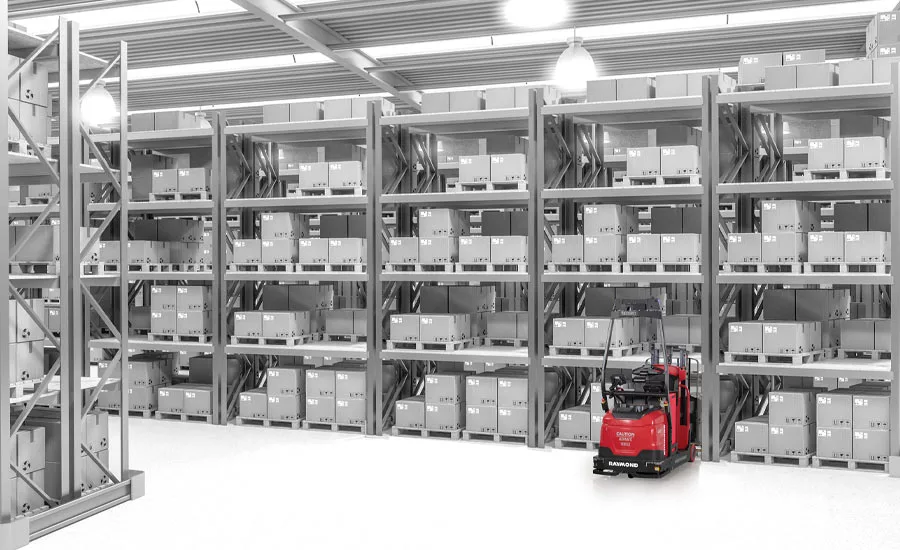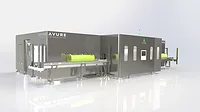Warehouse
Automation places pressure on lift trucks
Forklifts employ telematics, key safety measures

Music aficionados have long celebrated the collaborative rendition of “Walk This Way” featuring rock band Aerosmith and hip-hop group Run DMC for its amalgamation of two distinct genres. As automation becomes a bigger factor in warehouses, facility managers are hoping to achieve their own epic collaboration.
“Many industry experts will say the future of manufacturing is automation,” says Erica Moyer, product manager for pallet truck and stacker line for The Raymond Corp., Greene, N.Y. “The greatest opportunity for the material handling industry is the introduction of collaborative automation and operator assist technologies. Introducing automation into various processes creates preparation and programming tasks that a human will always have to handle. Ultimately, collaborative automation reallocates labor to more value-added tasks with greater flexibility and for a lower total cost of ownership.”
Mark Koffarnus, national accounts director for Yale Materials Handling Corp., Greenville, N.C., highlights labor retention and availability as a challenge that plagues warehouses, citing a turnover rate for warehouse workers at 46.1 percent, according the Bureau of Labor Statistics. Although automation could aid this obstacle, Koffarnus notes that such a transition does not happen overnight.
“Planning across five to 10 years can account for the continued evolution of technology and a changing competitive landscape,” he says. “A longer-term master plan also provides a critical platform to share future developments and gain buy-in for continued capital investment.”
Given these timelines, costs associated as well as embracement of collaborative automation, forklifts remain a key component within beverage warehouses. However, to support the ever-increasing demands of today’s operations, suppliers are increasingly turning to software solutions to deliver lift trucks that are efficient and safe for today’s operators.
Telemetry my dear, Watson
Given the number of touchpoints associated with forklifts, knowledge is power for operators. As such, telematics is becoming a stronger player in warehouse management.
“It’s about keeping management as informed as possible, both in terms of day-to-day management and long-term fleet management decisions,” says Gijo George, director of national accounts for Hyster Co., Greenville, N.C. “Lift truck telemetry provides visibility to lift truck equipment status and operator behavior to improve the efficiency of lift truck fleets. These systems allow fleet managers to improve maintenance and fuel informed decisions about fleet size and composition.”
Perry Ardito, general manager of the warehouse and automation products group for North America at Houston-based Mitsubishi Caterpillar Forklift America Inc. (MCFA), explains how telematics can help warehouse managers make decisions about the size of their fleet.
“For example, if a company has too many forklifts, how do they know that? With telematics it’ll capture the utilization of that forklift over a period of time,” he says. “As an example, if they had 10 forklifts and they see that eight of them are operating at a high level, say the utilization is operating at 70 to 80 percent, but they have two, three or four that are operating at a much lower utilization rate over a period of time, again they can make some decisions as to whether in fact they have to keep that size of fleet.
“Therefore, they can trade or sell existing forklifts and then also reduce the number of operators for those low utilization units,” he continues. “I think telematics or fleet management are synonymous and it allows them to capture fleet data that they are able to run reports with to make good decisions of whether they have the right size fleet, even the right equipment to manage their operations.”
Raymond’s Moyer echoes similar sentiments regarding telematics and forklift utilization.
“Telematics assist in right sizing a forklift fleet that is tailored to meet specific needs, refine maintenance schedules to avoid overspending, and can even detect minor issues before they turn into expensive repairs,” she says. “Solutions like [Raymond Tracking Location System] (RTLS) can enhance efficiency and productivity by assisting operations managers to monitor the movements of lift trucks, personnel and assets in warehouses and to reinforce proper operational practices.”
Suppliers also continue to improve upon the telemetry capabilities for lift trucks. Yale Vision now is equipped with a telemetry camera, Koffarnus says.
“The Yale Vision impact camera is a new feature available through the Yale Vision telemetry system that uses front- and rear-facing cameras to capture footage the entire time the truck is in operation,” he explains. “If an impact occurs, the system automatically saves footage just prior to, during and after impact if an accident occurs. The impact sensor of Yale Vision already provides managers with the who, the when and the where — now, with the camera, they can see the what.”
Hyster Tracker also has upgraded its capabilities will camera capabilities. “The Hyster Tracker telemetry solution can even monitor lift truck batteries and offers a mobile app available to any internet connected device, helping keep managers better informed no matter where they are,” George says. “Most recently, Hyster launched a camera feature to record the circumstances before, during and after an impact event. If an operator has a collision that sets off the impact sensor, the camera automatically saves footage so that management can see exactly what happened — in addition to the other relevant data provided by the system.”
Safety first
The proliferation of telemetry solutions within forklifts helps support an important topic for the material handling equipment: safety.
“Safety isn’t an outcome, it’s a culture,” Yale’s Koffarnus says. “Safety is everyone’s job and must extend across operations and the supply chain.”
MCFA’s Ardito explains how telematics systems allow for safety measures at the beginning of a shift as well as capabilities to prevent unsafe operations.
“[T]his is something that we at Jungheinrich are offering, [which] is a mechanism built into the trucks that recognize if there is an unsafe operation happening and then takes proactive measures to either slowdown the truck or often times, bring it to a stop,” he explains. “We utilize with some of the Jungheinrich models RFID transponder technology that helps regulate speeds within the aisle to slowdown the truck, stop the truck, even restrict lifting where there’s overhead obstructions that would cause overhead damage as well. So, you have telematics on one end that the operator needs to perform certain functions, enter in some data before they’re able to utilize the truck and you have technologies built into the trucks themselves that effectively monitor the performance and use of the lift trucks like RFID transponder technology.”
Beyond traditional safety measures, warehouses also are taking a deeper look into sanitary procedures in the wake of COVID-19.
“Regarding safety in the age of COVID-19, equipment sanitization is an important step to help combat the risk of virus transmission,” Hyster’s George says. “The Centers for Disease Control and Prevention issues guidelines, and translating those to lift truck service and daily operation is important to getting back to work safely. The HY-Shield Clean initiative identified the most common touchpoints for each lift truck product class to offer tailored recommendations according to equipment type. Personal protective equipment like masks and gloves, along with proper sanitization supplies are also important.”
Yale’s Koffarnus explains the importance of knowing the high touchpoints of a lift truck to effectively sanitize the vehicle. “Whether a technician visiting for a service call or an operator preparing for a normal shift, all personnel who interact with a lift truck should wipe down and sanitize the lift truck, work area and any tools before starting work and again once they finish,” he says. “Consistent application of sanitization procedures is key.”
Further supporting safety during COVID-19 times, Yale recently debuted a tag-to-tag solution that buzzes whenever employees get within 6 feet of one another, Koffarnus adds.
Looking for a reprint of this article?
From high-res PDFs to custom plaques, order your copy today!






